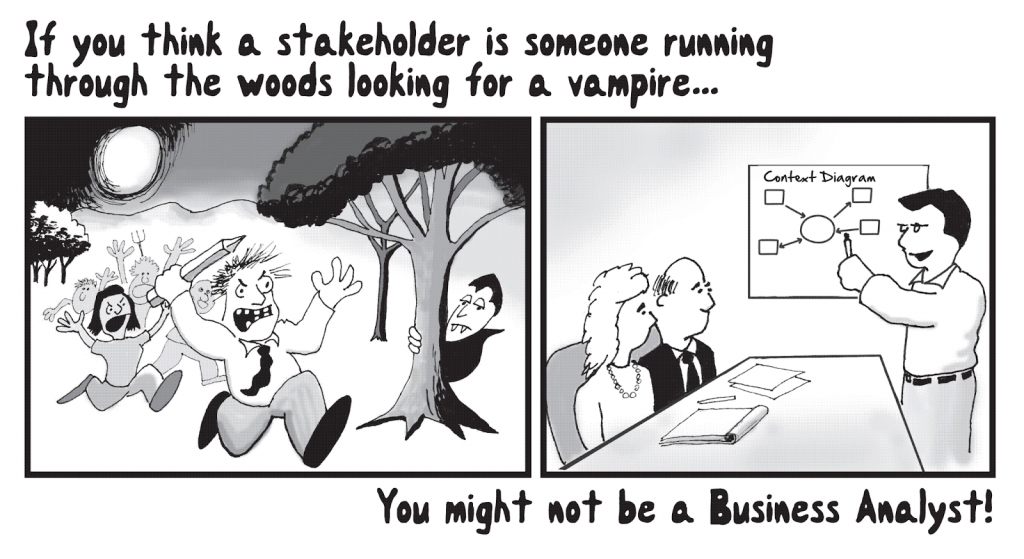The release of R. Edward Freeman’s book Strategic Management: A Stakeholder Approach in 1984 and the further development of stakeholder theory prompted project managers to increasingly orient their work towards stakeholders as they are those for whom its consequences will have the most impact.
But who (or what) is the stakeholder?
The answer to that question, which academics have mulled over for the past three decades, is still propelling the careers of countless professors.
In theory, every project could be said to influence everyone somehow. Just like a small stone that, when dropped in a lake, creates ripples that disturb the entire surface of the water.
At the same time, however, one has no power to design for everyone. Priorities must be made, and the needs of our project are too immediate to wallow in ifs and perhapses. You need to find a way to quickly identify those who your project will impact most, people whose trust you need to gain during the process, and whose influence the project hinges on the most. You need to involve yourself in stakeholder mapping. And this article will help you to work your way into it.
Contents
What is stakeholder mapping?

Stakeholder mapping in UX is the process of identifying, analyzing, and prioritizing the principal players who your project will most positively or negatively influence. Think of it as a way to assemble the puzzle pieces that will reveal the bigger picture of your project's success.
Stakeholders can be anyone from customers to employees, suppliers to investors, regulators to community organizations. They have distinct interests, concerns, and expectations. So project managers should be aware of these to ensure project success.
When designers use stakeholder mapping in UX, it's like peering into a telescope to explore the vast expanse of stakeholder relationships. All to discover the galaxies of design elements and functionality that will truly captivate and inspire those who matter most. With this tool, designers and product teams can understand the infinite complexities of stakeholder interests, needs, and expectations. Understand and craft a design solution that shines like a supernova, illuminating the way forward for all who use it.
By navigating the cosmos of stakeholder relationships, UX designers can create a masterpiece that not only meets the needs of their clients or employers. They also may elevate the user experience to new heights. So stakeholder mapping in UX is a powerful tool that enables designers to unleash their creativity and transform their visions into reality, leaving a trail of stardust in their wake.
Pro tip: Knowing who the stakeholders are is also beneficial at later stages. E.g., when you are planning a project review process.
Stakeholder Quadrant
And you can do one of the simplest and most powerful kinds of stakeholder mapping on a piece of paper or whiteboard.
Such a map is self-evident. You see which parties require the most attention (high level of interest, high power level) and which parties require the least (low level of interest, low power level).
Development Impact & You (DIY) has come up with an approach to stakeholder mapping in UX that focuses on external stakeholders. This method promises to have a significant impact on your development efforts. So, if you're looking to engage with your external stakeholders effectively, keep reading.
When do you need stakeholder mapping in UX?
With small projects, it can sometimes be clear from pure instinct who the stakeholders are and how to design for them. When your project gets larger, either financially or in terms of ultimate impact, more stakeholders will be involved. And it’s a much more challenging task to design for them.
For large-scale projects, stakeholder mapping can be critical to determining design priorities. Creating a stakeholder map in UX design projects is the first step towards understanding where to focus your time and money. By identifying and analyzing the needs, expectations, and interests of each stakeholder, you can prioritize your design efforts effectively. This, in turn, will help ensure that your project meets the needs of all stakeholders while achieving the desired outcome.
As a project grows more intricate, its effects may not be immediately apparent. It's like trying to see the forest for the trees—the bigger picture can be obscured by the details.
Take a step back and consider who stands to gain from the UX design project, what power and interest they have, and how they will benefit. It's important to look beyond the surface level and understand the nuances of the impact.
By having a crystal-clear understanding of who the project will benefit and how, you can fine-tune your design to maximize its simplicity and effectiveness. This knowledge will serve as a compass, guiding you towards the most efficient and impactful solution.
Beyond supporting the idea of efficiency and consumer impact, stakeholder mapping in UX can make or break a project.
As the cost of a project increases, the stakes become higher, and the riskier it becomes. In such situations, stakeholders with a significant level of interest and power can play a critical role in tipping the scales from "maybe" to "go-ahead."
It's important to recognize that the same stakeholders who can push a project forward can also block it, undermine your position, and ultimately lead to failure. In such cases, the responsibility for the project's failure usually falls on the shoulders of the project manager. Therefore, it's crucial to identify and prioritize these stakeholders and their interests.
Stakeholder mapping in UX is a comprehensive approach that can help ensure that you and your team are consistently building trust with interested and influential stakeholders while also keeping the end-user's needs in mind. And by mapping out the stakeholders' interests, power, and influence, you can tailor your approach to ensure that all parties are satisfied with the project's outcome, identify potential roadblocks, and work to mitigate them before they become serious issues.
Internal vs. external stakeholders
If you’ve read up to this point, you might have noticed a marked difference in the kinds of stakeholders we discuss.
When it comes to project development, there are two groups of stakeholders to consider. One is those within the organization who have power and interest, who make an impact on the project's direction. The other is those outside of the business who are affected by its outcomes. This line between internal and external stakeholders is an important one to consider. But it's not the only distinction that can be made.
External stakeholders, for example, can vary widely in terms of their relationship to the project and the organization. Some may be customers or clients, while others may be regulatory bodies or community groups. Each has a unique perspective and set of needs that must be considered when developing a project strategy. Don't underestimate their power.
Beyond this, there are also distinctions to be made within the internal stakeholder group. For example, there may be different departments or teams within the business that have competing interests or priorities. In these cases, it's important to identify and prioritize the needs of each group. Then work towards finding a solution that meets everyone's needs.
Of the internal and external stakeholders, you can identify primary, secondary, and what we call key stakeholders.
Let’s imagine your UX project to be a rock thrown into a pond. The primary stakeholders are the ones who are immediately splashed by the impact—they're right in the center of the action. The secondary stakeholders are a little further out, feeling the ripples but not getting soaked. And then there are the key stakeholders—these are the ones who may not be in the water at all, but they're holding the fishing poles and deciding what to do with the fish. They have the power to make things happen, even if they're not directly impacted by the project. So, when you're planning your project, you need to think about all the different people who have power and/or might be affected, whether they're in the water or not. Because in the end, it's the key stakeholders who can help you make the biggest splash.
Even after that, you can put stakeholders into groups based on motivation and interest. In your UX testing and research, you may have identified personas into which stakeholders can be grouped.
In addition, there may be certain individuals who hold a unique position within the company, such as a CEO. They have their own ideas and goals, and they're the ones who can make or break your project. So, it's super important to take their perspective into account when you're planning things out. If you can understand what they're looking for and what they care about, you'll have a much better chance of making your project a success. It's all about getting on the same page and working towards the same big picture.
Using stakeholder mapping, you can visually communicate or represent who has the most to gain or lose from your UX design, who has the most influence, and who has the most resources at their disposal.
When it comes to stakeholders, it's the big players with deep pockets, high stakes, and tremendous sway that require constant coddling to keep them on board. But don't forget about the minor players, too. It's a key aspect of design thinking that focuses on the end-user. Stakeholder mapping is like creating a delicious recipe where the needs and wants of powerful stakeholders are the main ingredient. And there the satisfaction of end-users is the perfect seasoning that ties everything together.
With stakeholder mapping in UX, you can mix and match the right ingredients and create a project that leaves everyone's taste buds tingling with delight.
After all, what is UX if not a love of, and empathy for, the end-user?
How to create a stakeholder map in UX (spoiler: stakeholder analysis)
To create a stakeholder map in UX, you need first to begin a process called stakeholder analysis.

Stakeholder analysis
During stakeholder analysis, the UX designer creates a list of all the stakeholders involved in the project. Then categorizes them based on interest and begins to think about their motivations.
As the UX designer embarks on this exciting journey, they carefully map out the landscape. They are tracing the paths of those who will be impacted by the project. They are exploring the nooks and crannies where their interests lie. With a keen eye for detail, the UX designer expertly categorizes each stakeholder according to their level of involvement. Then begins to unravel their motivations. They consider the needs of the investors who fund the project. The desires of the end-users who will ultimately benefit from it. And the aspirations of the developers who will bring it to life.
Yet to begin stakeholder analysis, you should start with brainstorming, possibly getting the whole team involved. Who serves to be impacted by our project?
Possible stakeholder list for stakeholder analysis:
- CEO;
- Manager;
- Shareholders;
- The team;
- Suppliers;
- The community;
- Our families;
- The list can go on and on.
Now, it's time to put all the names on the list into stakeholder analysis action!
Creating stakeholder maps is like drawing a family tree. But instead of tracing your ancestry, you're charting who's affected by your project! It's like playing a game of 'who's who' on a big whiteboard. Exexcept this time, you're grouping people based on their motivations, benefits, and impact. And just like a family tree, you'll need to rank these folks based on priority.
Think of stakeholder analysis and mapping as a fun and interactive way for you and your team to visualize the inner workings of your project. Sticky notes on a whiteboard will do just fine. But if you're feeling fancy, you can use some of the many online tools available to create a digital mind map.
Find the right groups and people
Now, let's dive into the sea of "interested parties" and put them into their respective swim lanes. Let's separate the big fish from the little fish and see who's in it for the long haul.
A good stakeholder map in UX will clearly show for whom to prioritize the project.
First, separate stakeholders into two groups: those who are part of the organization (internal) and those who are not (external). Then, organize them further based on their role in the project. You can do this by considering factors such as their level of influence or power, how much they stand to be affected by the project, and other relevant criteria. By categorizing stakeholders, it becomes easier to develop a targeted approach to managing their expectations and involvement in the project.
As a savvy designer, it's important to identify the key players within your organization. Those who have a vested interest in the design process. You'll want to seek out people who are most engaged and enthusiastic about design thinking. Seek and keep them in the loop throughout the project. After all, they could be your biggest advocates (or critics) down the line.
By understanding this internal party’s familiarity with design thinking and their vested interest in the project, the designer can assess when and how to involve them.
When you've created these groups, let's give each group our undivided attention and rank their stakeholders accordingly.
How to do this?
Internal stakeholders
Remember the grid for measuring the power of the stakeholder and their level of interest? It’s time to use it.
It’s also a good idea to brainstorm a list of all your internal stakeholders. It will be extremely helpful when it comes to prioritizing.
External stakeholders
External stakeholders can be more tricky to prioritize. In the broad stroke of “end-user,” who serves to gain more? There are a few analysis techniques we can use to assess this.
In one method, the fundamental analysis technique, the challenge owner grades qualitatively what user personas should exist for a specific UX component.
Suppose you examine CarMax’s “CarMax Delivers” page, for example. If you look closely, you'll find some comments from customers who used CarMax's car delivery service that was created with the help of UX design. These comments reveal some personalities of users.
It is no accident these quotes exist on this page of the website. Having done their user research, the CarMax design team created personas for the kinds of customers that would most benefit from their service.
These personas were, of course, based on real interviews with real people.
The UX team at CarMax employed a fundamental analysis technique in this case. They examined qualitatively which end-user would most benefit from the service. Then catered the design to them.
Another method, the technical analysis method or target audience analysis, uses ads, social media, and other strategies to gain information. Whereby you can segment groups geographically, socioeconomically, or psychographically.
Merge and split groups
Once you've created your groups, you can reassess the entire stakeholder map using the following questions:
- Are these the right groups?
- Should we merge some groups?
- Maybe we should split some groups apart?
- Do the groups share enough characteristics that you can merge them?
- Perhaps certain groups could be two separate groups?
- What makes a group separate from another?
Start building trust
At the core of the UX design thinking process lies the task of fostering trust, both with end-users and internal stakeholders. Yeah, an effective design should instill a sense of trust in users. But it's equally important for UX designers to prioritize building trust with colleagues and partners involved in the project.
By understanding the internal stakeholders’ focus on the end-user, the designer can create and share a better plan for building trust with that stakeholder.
Imagine a scenario where a powerful stakeholder is a bit of a newcomer to the world of design thinking. As a savvy designer, you have a trick up your sleeve: involve them from the get-go! By bringing them into the process early on, you can show them the ropes while also gaining their valuable input. Who knows, you might even win them over to the user-centered approach! With a little creativity and a lot of collaboration, anything is possible.
At the same time, a stakeholder with a high level of involvement with design thinking might be “made a conspirator”. And you can ask them for advice and counsel.
If you want to conquer this task, communication is your trusty steed. Keep your top stakeholders in the loop and watch as their high interest blooms. This way, you'll build trust and be the hero of the day, all thanks to your stellar communication strategy.
Conclusion of the topics
At the end of the day, discussions surrounding the stakeholder and the end-user go back to what design is about in the first place: an empathetic approach to business that combines good economics with ethics.
Stakeholder maps in UX create the first bridge between your design and the people that it can help.
Delving into the intricacies of stakeholder analysis could take a lifetime, but we've provided a solid foundation to get you started on your journey towards creating meaningful projects or refining your existing UX design process. Just remember, that the philosophy of stakeholder theory is always evolving and striving to make the world a better place, one design at a time. So let's take that first leap forward and see what impact we can make through fruitful stakeholder relationships.
This article was originally published in August 2021 and has been updated in December 2022.



As a consultant, I always do stakeholder mapping for UX when I start working with a new company. You have to accommodate all the sponsors, high-level management, team members… It seems overwhelming at first, but once I have the priorities written down, I feel more confident.
When I first wondered how to do stakeholder mapping, I always thought it revolves around internal experts only. It was interesting to find out that customers are on the list as well. I guess at different stages of the project, the priority that stakeholders have also changes. It’s all about the buy-in early on and customer satisfaction at the end.